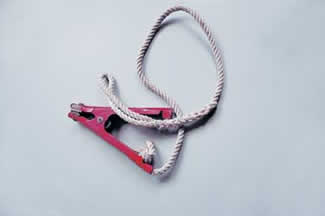September 01, 2016
By Steve Kantner

Spoil the reed and spare the fish.
Let's face it. Dropping even the smallest anchor in a tidal creek or wilderness canal can turn off the fish. Whether it's the splash, or simply because fish sense your presence, they can be frightened by anchors, particularly in tight quarters. And the inevitable bumping of the anchor on deck is another turnoff for nearby fish. But whether you're in a shallow-draft flats skiff, a canoe or a kayak, you'll eventually need to hold your boat in position on these productive little flowages, most of which get very little fishing pressure and many of which hold huge snook, reds and even baby tarpon.

Jumper cable clamp and dock line for "anchoring" a small boat to shoreline vegitation. |
There is, in fact, a simplified solution that's easily assembled from materials you may already have. Josh Zwerner of Vero Beach, who showed me the rig, calls it a “grass anchor.”
With this setup, you don't lower anything over the side. Instead, you simply attach the clip, which is looped around a thwart or cleat, to a sprig of streamside vegetation or a mangrove root. There's no struggling with wet anchor ropes and slimy chains. And for canoes and kayaks, which are usually launched by hand, there's less weight than with a conventional anchor—always a good thing when you're carrying gear from the car to a launch point somewhere back in the mangroves.
The clip system can also be used in conjunction with a pushpole, to allow you to fix the position of your boat on flats where there's no shoreside vegetation handy. You'll simply stick the pole, take a couple turns around it with the line, and then clip the line to itself—no knot needed.
All you'll need is a 3- to 4-foot length of 3/ 8- or 5/ 16-inch twisted nylon rope, a heavy-duty battery clip of the sort used in jumper cables, a cigarette lighter, and a roll of electrical tape. It also helps to have a pair of pliers. The 1/ 2-inch diameter shrink tube and a heat gun mentioned in the following steps are optional.
Start by forming a loop in one end of the rope. The loop should measure approximately one foot in diameter. You can make it any way you like, including with a good knot. However, if you'd like to produce a professional result with minimal effort, make a spliced loop. We described this in an earlier edition of Florida Sportsman, but here's a quick reminder:
First, secure the ends of the rope with electrical tape, or melt them together to prevent the twist from unwinding. Untwist a section of rope approximately two feet from one end, in order to lay open the three major strands. Pass one end of the rope under a strand of the unraveled twist and pull it through approximately four inches. Open another section of the rope twist and push the end through that, as well. Now grip the line on either side of the splice and pull to tighten the strands back together and secure the bitter end.
The splice you've created resembles a “Chinese handcuff”. To lock it in place, slide a 5-inch length of 1/ 2-inch shrink tube over it and apply heat from a heat gun. Several tight wraps of electrical tape will also work, but the tape deteriorates over a few months of use and has to be replaced.
Now here's the easy part: Pass the free end of the rope through the handle of a heavy-duty battery clip (available at auto supply stores) before tying an overhand knot. Afterwards, melt the knot with a lighter flame. The knot should secure the clip to the rope, but use pliers to crimp the handle where the battery cable normally attaches to secure it tight on the standing part of the line.
That's all there is to it. In order to use this contraption, fit the loop around a thwart or cleat and grab a fistful of cattails with the clip. The spring pressure is strong enough to hold your boat despite any wind you'll encounter in a coastal creek. And it works on all sorts of vegetation, including needle rush grass and sawgrass; both can be tough to try to loop a line around.
This rig has turned out to be an ace-in-the-hole. I've caught plenty of fish while pinned securely against a cattail stand. In addition to not scaring fish, you don't have to slosh water and mud into the boat or tear up the bottom. And moving forward a few feet to get a better casting position is quick and silent. Stowage is a snap—you simply clamp it on the gunwale, where it's ready to go instantly next time you need it.
The Blakemore Brush Gripper, available for about $8 through some tackle retailers, is a ready-made product that does basically the same job. The galvanized steel, spring-loaded clamp comes complete with a 10-foot nylon tether.
FS
